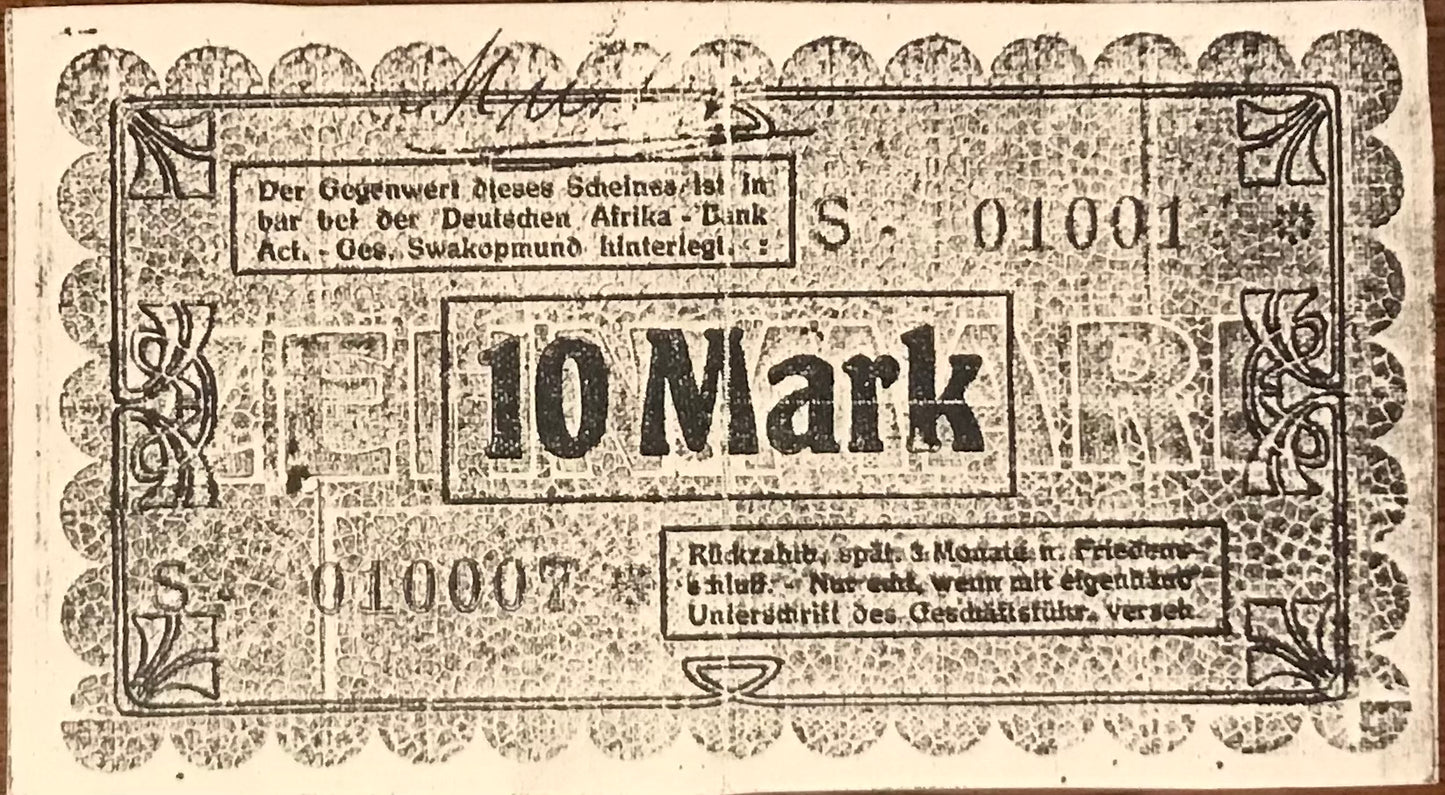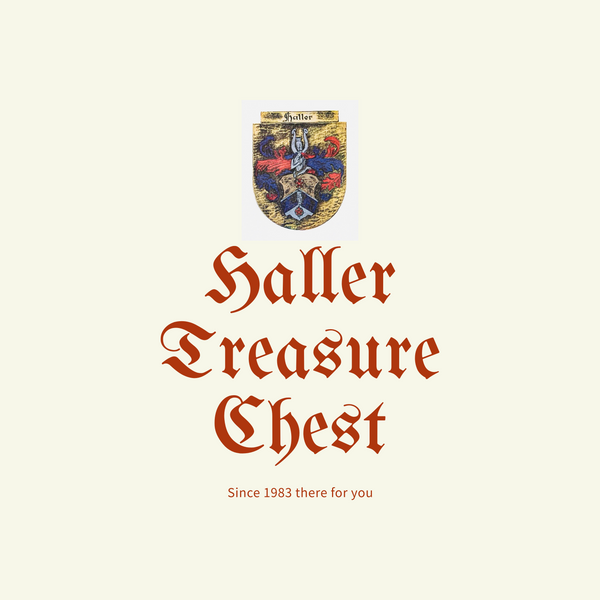Haller Treasure Chest
MV036 - Voucher copy / Gutscheinkopie - 10 Mark - Swakopmunder Buchhandlung - Januar 1917 -
MV036 - Voucher copy / Gutscheinkopie - 10 Mark - Swakopmunder Buchhandlung - Januar 1917 -
Couldn't load pickup availability
No. 010007: There was only 1 issue, which was apparently never released. Seen from the copy, top leave the word: 'Muster' (sample) is written. This is a copy only but still interesting to know for a collector in this field.
In the year of the bloody world war, this note became good, because the two-mark (according to the original wiez) and three-mark coupons already in circulation had to be withdrawn by order of the Secretary of the British occupation government on the twenty-eighth of January. From the Swakopmund Gesellschaft mit beschränkter Haftung zu Swakopmund bookshop under the direction of the then Managing Director, Hrch Stolze. In the interests of the population during this difficult period of war, the bookshop took on the task of supplying the protectorate with currency to the value of around sixty thousand marks. The equivalent value of the vouchers issued was deposited with the South West African Land Credit Organisation in Swakopmund. We hope that this facility has been of service to our compatriots and especially to traders. May it be duly recognised in the future.
After the complete occupation of the colony by the Union of South Africa in 1915, English currency was introduced. The imperial currency and Seitz notes that had been in circulation until then were declared invalid. However, because the changeover was totally unprepared, there was a shortage of small change and coinage everywhere. It was hoped to remedy this by allowing large companies to issue emergency money in denominations of 10, 25, 50 Pf, 1 Mark, 2 Mark and 3 Mark. Shortly afterwards, however, small and micro-enterprises also issued emergency money in paper form. Although the German banks accepted all these issues of emergency money as a means of payment, there was so much confusion in payment transactions that the German Chamber of Commerce in Windhoek asked the bookshop in Swakopmund to issue emergency money valid throughout the country. This emergency money then circulated throughout the colony as a valid means of payment.
Nr. 010007: Es gab nur 1 Ausgabe, die nie veröffentlicht wurde. Auf dieser Kopie steht das Wort: ''Muster'' rechts oben. Es ist eine Kopie, aber bestimmt interressant für die Sammler unter uns.
Im Jahr des blutigen Weltkriegs wurde dieser Schein zu einem Gutschein, da die bereits im Umlauf befindlichen Zwei- (nach dem ursprünglichen Wiez) und Drei-Mark-Scheine auf Anordnung des Sekretärs der britischen Besatzungsregierung am achtundzwanzigsten Januar eingezogen werden sollten. Aus der Buchhandlung der Swakopmund Gesellschaft mit beschränkter Haftung in Swakopmund unter der Leitung des damaligen Generaldirektors Hrch Stolze. Im Interesse der Bevölkerung in der schwierigen Zeit des Krieges hatte die Buchhandlung die Aufgabe übernommen, das Protektorat mit Geld im Wert von etwa sechzigtausend Mark zu versorgen. Der Gegenwert der ausgegebenen Schuldscheine wurde bei der South West African Land Credit Organisation in Swakopmund hinterlegt. Wir hoffen, unseren Landsleuten und vor allem den Händlern einen Dienst erwiesen zu haben, indem wir ihnen die Arbeit erleichterten. Möge sie später gebührend anerkannt werden.
Nach der vollständigen Besetzung der Kolonie durch die Südafrikanische Union im Jahr 1915 wurde die englische Währung eingeführt. Die kaiserliche Währung und die Seitz-Banknoten, die bis dahin im Umlauf gewesen waren, wurden für ungültig erklärt. Aufgrund der völlig unvorbereiteten Währungsumstellung kam es jedoch überall zu einem Mangel an Kleingeld und Münzen. Man hoffte, dem abzuhelfen, indem man den großen Unternehmen die Ausgabe von Notgeld im Wert von 10, 25, 50 Pf, 1 Mark, 2 Mark und 3 Mark gestattete. Kurz darauf gaben auch Klein- und Kleinstunternehmen Notgeld in Papierform aus. Obwohl die deutschen Banken all diese Notgeldausgaben als Zahlungsmittel akzeptierten, herrschte im Zahlungsverkehr so viel Verwirrung, dass die deutsche Handelskammer in Windhoek die Buchhandlung in Swakopmund bat, landesweit gültiges Notgeld auszugeben. Dieses Notgeld zirkulierte daraufhin in der gesamten Kolonie als gültiges Zahlungsmittel.
No 010007 : Il n'y a eu qu'une seule édition, qui n'a jamais été publiée. Sur cette copie, le mot: ''Muster'' (échantillon) est inscrit en haut à droit, il s'agit d'une copie, mais certainement intéressante pour les collectionneurs parmi nous.
En cette année de guerre mondiale sanglante, ce billet est devenu un bon, car les billets de deux (selon le Wiez original) et trois marks déjà en circulation devaient être retirés le vingt-huit janvier sur ordre du secrétaire du gouvernement d'occupation britannique. De la librairie de la Swakopmund Gesellschaft mit beschränkter Haftung à Swakopmund, sous la direction du directeur général de l'époque, Hrch Stolze. Dans l'intérêt de la population en cette période difficile de la guerre, la librairie s'était chargée d'approvisionner le protectorat en argent pour une valeur d'environ soixante mille marks. La contre-valeur des billets à ordre émis a été déposée auprès de la South West African Land Credit Organisation à Swakopmund. Nous espérons avoir rendu service à nos compatriotes, et surtout aux commerçants, en leur facilitant la tâche. Puisse-t-elle être dûment reconnue par la suite.
Après l'occupation complète de la colonie par l'Union sud-africaine en 1915, la monnaie anglaise a été introduite. La monnaie impériale et les billets Seitz, qui avaient été en circulation jusqu'alors, ont été invalidés. En raison de l'impréparation totale du changement de monnaie, il y eut cependant partout une pénurie de monnaie et de pièces. On espérait y remédier en autorisant les grandes entreprises à émettre de la monnaie d'urgence d'une valeur de 10, 25, 50 Pf, 1 Mark, 2 Mark et 3 Mark. Peu après, les petites et micro-entreprises ont également émis de la monnaie d'urgence sous forme de papier. Bien que les banques allemandes aient accepté toutes ces émissions de monnaie d'urgence comme moyen de paiement, il régnait une telle confusion dans le trafic des paiements que la chambre de commerce allemande à Windhoek demanda à la librairie de Swakopmund d'émettre de la monnaie d'urgence valable dans tout le pays. Cette monnaie d'urgence a ensuite circulé dans toute la colonie comme moyen de paiement valable.
Share




